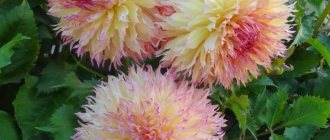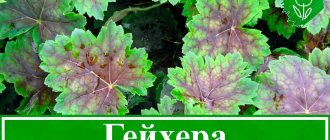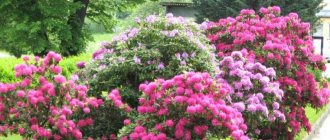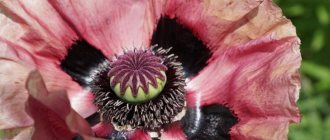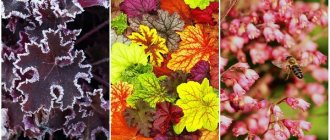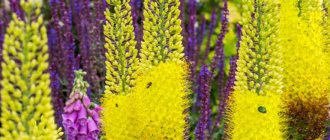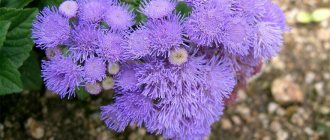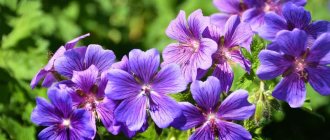Botanical description
Heuchera hairy
Heuchera is a herbaceous plant about half a meter high . There is no central stem as such; the leaves are mostly basal. The length of the petioles can reach 30-40 cm. The leaves consist of five fused lobes, their size is about 5 by 10 cm.
1 The root system of a plant has a rod structure. The central root is quite large and fleshy. Sometimes there may be several roots on one bush; as a rule, this happens when additional roots naturally budding from a larger one. The root length can reach up to 50 cm.
Bushes of various types of heuchera
2 The flowers of the plant are small, mostly inconspicuous. However, some species are quite bright. Their color can vary from white and green to bright red or pink. There are practically no single flowers; they are mainly collected in panicle-type inflorescences.
Heuchera bloody inflorescence
3 The fruits of the plant are capsules containing several thousand seeds. The seeds are extremely small, slightly smaller than a poppy seed. One gram contains up to 20 thousand seeds.
The modern classification of heuchera does not have a single standard. In fact, there are two classifications of the plant: according to one, the genus has 58 species, according to the other - more than 70. The varietal diversity of the plant is quite large.
Over several decades, about 400 varieties and hybrids of the plant were obtained, differing in leaf color and size.
Some Heuchera species are capable of interbreeding with related plants of the same Saxifraga family . An example of such a cross is a hybrid of heuchera and tiarella.
Its distinctive feature is a plant with colorful foliage and fairly large inflorescences.
A variety of colors of heuchera leaves in different varieties
Heuchera is very unpretentious and can grow even on rocky soils completely devoid of soil. There are several species found in the wild, native to the deserts of California and Arizona.
Obsidian, the darkest variety of heuchera
The plant propagates in all possible ways - from vegetative to seed.
Trimming
In spring, sanitary cutting is carried out to remove damaged, dried out and frozen stems in winter. It is not recommended to prune the plant in autumn. The procedure reduces the frost resistance of the crop. Heuchera blood-red needs preventative mulching after pruning. To improve the decorative properties of the plant, formative pruning is performed. This procedure is aimed at giving the bush the desired configuration.
One pruning per year is enough. For rejuvenating purposes, the previous growth of green mass is removed, which contributes to the intensive development of fresh shoots. Defoliation impairs the plant's ability to photosynthesize.
After pruning, heuchera needs more sunlight. Liquid consumption by the crop is reduced. Therefore, the frequency of watering after pruning is reduced. Overmoistening is a common cause of death of flowering plants after such agrotechnical measures.
Landing
Choosing a landing site
This is a very important question because there is no clear answer to it. Adult plants do not tolerate life in sunny areas, preferring shade and partial shade, but this situation is contraindicated for young plants.
The growth rate of young plants in shaded areas is very low and you will have to wait a relatively long time to get beautiful bushes.
Heuchera in a flowerbed
Since the plant tolerates replanting and root separation well, it is recommended to plant the plants in the sun at the beginning of cultivation, and then plant adult plants in shaded areas. Therefore, if you purchase a plant with a developed root system, it sits in the shade.
When planting young or seed propagation of heuchera, planting should be done in a sunny area.
In addition, young animals do not tolerate cold winds well, so the place where they are planted should have protection at least from the north side.
All varieties of heuchera react very negatively to waterlogging of the root system, therefore, growing them in lowlands and any places with high groundwater levels is not recommended.
There is another recommendation for choosing a place for a plant, based on the color of its foliage. Varieties with lightly colored leaves (such as yellow, white or silver) will do well in sunny areas.
While darker ones (green, burgundy, raspberry and blue) grow much better in shading.
Soil for the plant
Heuchera comes from mountainous and rocky areas, where the soil has a predominantly neutral or slightly alkaline environment. Most of the soils of the European continent, if they differ from neutral, are in the direction of oxidation.
Therefore, the soil for heuchera requires liming. Depending on the acidity, liming with ash or dolomite flour can be used.
Dolomite flour is used for liming the soil
The plant does not like too heavy soils; light and well-water- and air-permeable soils are preferable. The plant also requires drainage. It is made from broken brick or large crushed stone; The thickness of the drainage layer must be at least 5 cm.
Planting seedlings
It is most preferable to plant seedlings in mid-spring . Seedlings can be purchased or obtained through vegetative propagation of the plant. In both cases, the measures for planting them are absolutely identical.
Heuchera seedlings
The procedure for planting seedlings is as follows:
1The stems of the plant must be trimmed to young tissue, and shoots that may have dried out should be cut to the level of living brood buds, which are usually located in the axils of the foliage.
2Preparation of the root system involves removing diseased, damaged or fungal-infected areas. Such parts of the root should be completely removed, and the sections should be treated with crushed charcoal.
3Planting is done in squares or in a checkerboard pattern. The distances between plants in a row and between rows are 50-60 cm.
4 A hole with a diameter and depth of 30 cm must be dug under each bush. A drainage system must be placed at its bottom, which is covered with a layer of soil of about 5 cm on top. Next, mineral or organic fertilizers are added to the soil. Nitroammophoska can be used as a mineral (no more than 15 g per plant). Organic matter can be a layer of humus or compost (about 3-4 cm).
5 A young seedling is placed in the center of the hole and covered with soil. The soil is slightly compacted and watered with 3-5 liters of water.
6For the first 2-3 days, it is advisable to shade the plant, after which the protection from direct sunlight is removed.
Planting heuchera seedlings
Complete rooting occurs approximately 40-45 days after planting. It is during this period that the plant can already be transplanted to a permanent place. However, there is no need to rush - it is best to do the transplant at the beginning of the next season.
Planting by seeds
Heuchera seeds
This is not the most common planting method, but with its help you can get a much larger amount of seed material at lower material costs. Growing heuchera through seedlings is quite simple and not burdensome. Moreover, its seeds, subject to storage conditions, have a germination rate close to 90%.
It is believed that the viability of seeds stored outdoors or in a paper bag is six months. The use of sealed packages or foil packages, which prevent access to the seeds not only of moisture, but also of light, extends this period to one and a half years.
After these deadlines, almost all seeds become unusable, so it is recommended to carefully check the dates of seed collection and packaging.
Sowing of seedlings usually occurs in late March or early April. Therefore, you should check whether the expiration dates of purchased seeds correspond to the planting dates.
The seedlings are planted in a box with drainage holes. The height of the box must be at least 5 cm. Any plastic container can be used as a container for growing, even cut off lower parts of large plastic bottles.
The main thing is to make drainage holes in them. It is also allowed to grow plants using peat tablets with a diameter of 27 or 36 mm.
Seedlings after germination
Seedlings require loose soil. Its composition is not of fundamental importance. It can even be ordinary garden soil, or a mixture consisting of equal proportions of peat, garden soil and sand.
If regular soil is used, it is recommended to mix it with a small amount of sand or perlite to improve its air and moisture permeability. The volume of sand or perlite is taken from 1/5 to 1/3 of the total volume of the soil mixture.
The soil must be thermally treated in order to kill the fungi in it. To do this, you should either pour boiling water over it, or place it in the oven for half an hour at a temperature of +110°C. After that, the soil must be dried for 24 hours and only then can you start planting the seeds.
Heuchera seeds are very small; sometimes it is recommended to mix them with sand when planting. The small size of the seeds does not mean they are buried in the ground. Therefore, after preliminary preparation of the soil, you should level its surface and moisten the top layer with a spray bottle.
Sowing is carried out directly on the soil surface. After which the box with seeds should be covered with glass or film.
Seeds require a large amount of light to germinate, so it is recommended to immediately place the box with them on the windowsill of a south-facing window. In this case, it is necessary that the temperature in this place be around + 18-20 ° C and there are no drafts.
Every day the box with seeds should be ventilated by removing the film or glass for 15 minutes. Watering should not be done daily, but as the soil dries. In about 15-20 days the seeds will sprout.
The film or glass should not be removed. They need to be raised a little; in some cases, several small holes are made in the film.
Picking seedlings is done when three true leaves appear on it . Seedlings are planted at distances of 4 to 6 cm between them. During this time, the soil should be kept moderately moist.
Seedlings picked into separate containers
Next, there are two options for further growing seedlings. Continue growing plants indoors or transplant them into open ground in a sunny area. Each of them has its own advantages and disadvantages.
Since a normal rosette is formed in heuchera within about one year, it is best to continue growing indoors. In this case, around June-July, the seedlings should be transplanted into larger boxes.
In the summer they can be taken out into the open air, or even remain there continuously until the end of the season, but with the onset of cold weather they are again placed indoors. The final planting of seedlings in open ground takes place in the spring of next year. This growing method is applicable in areas with harsh winters.
If cultivation takes place in milder conditions, it is possible to plant the plants in a sunny area in the garden already in mid-summer, corresponding to the year of planting. In this case, the plants will be better adapted for further cultivation.
However, in this case they will need to be covered for the winter with a layer of mulch about 10 cm thick. Peat, sawdust or compost should be used as mulch material.
Plant care
Mulched heuchera bushes
Directly maintaining heuchera in a healthy form does not require practically any action from the owner, since the flower, accustomed to growing in desert conditions, tolerates both summer and winter of temperate climates.
Watering should be seriously limited, since in fact even the level of natural precipitation in a temperate climate is excessive for heuchera.
To maintain the required level of moisture in the soil for a long time, it is recommended to mulch the soil around the plant with sawdust or pine needles in a layer of 3 to 5 cm. For mulched plants located in the shade, the amount of natural precipitation will be quite sufficient. Watering should only be done if the soil dries out excessively.
Plants located in open sunny areas should be watered at an average frequency of 1-2 times a week. To maintain soil moisture, mulching of such plants is mandatory.
Even poor soils for mature plants have a sufficient level of fertility. However, you should not completely ignore fertilizing: once a year, at the end of the season, it is recommended to mulch the plants after autumn pruning with a layer of peat or a mixture of peat and humus in a ratio of 1 to 1.
The above applies to decorative deciduous varieties of heuchera. There are also several dozen decorative flowering varieties. They require fertilizing with complex flower fertilizers before and after the flowering period.
Of all the procedures for caring for a plant, the procedures of pruning and loosening the soil remain the most relevant. The need for pruning in temperate climates increases significantly, since the abundant growth rate causes rapid growth of leaves. This leads to a strong thickening of the bushes and the plant simply becomes crowded.
Watering the plant before loosening
Typically pruning is done at the beginning and end of the season. The plant is actually evergreen and many of the leaves that appear in the second half of summer can easily survive the winter.
Pruning at the end of the season consists of removing diseased and damaged parts of the plant , as well as trimming excess side shoots and petioles that have lost leaves. But even old leaves are not removed during autumn pruning.
Removal of too old, as well as diseased and injured leaves is done in early spring. Also at this time, formative and stimulating pruning of the bush is performed.
Loosening the soil is important because the plant's root system needs a lot of air. The rocky soils of the plant’s homeland allow this process to proceed without problems, but in the heavy soils of the temperate zone the plant may have certain problems.
Typically, loosening is done once every 2-3 weeks. In this case, the soil in the area with heucheras is watered with a very small amount of water (to wet only a 2-3 cm layer at the surface) and loosened to the same depth.
Simultaneously with loosening, it is imperative to carry out the procedure of hilling the bushes, since the core of the bush is constantly sticking out of the ground. However, you shouldn’t be too zealous about this either.
The main thing in hilling is to cover the sockets to prevent them from drying out or frostbite.
The best varieties
Heuchera blood-red has many natural and artificially bred varieties intended for use in the design of various spaces and creating attractive floral compositions. The culture has about 70 varieties. Heuchera varieties found in nature are conventionally divided into forest and mountain.
The most popular varieties are presented in the table:
| Name | Botanical description |
| Coral forest | The plant differs from other varieties in its large, bright green leaf blades with unusual marbled veins. During the growing season, small buds of a coral shade are formed on strong peduncles. |
| Splendence | A relatively large perennial plant with a height of 50-60 cm. Carmine-red petals highlight the refreshing mint color of the foliage. |
| Leithafer | The variety is determined by the characteristic glossy surface of the scarlet petals. The average plant height is 40-45 cm. |
| Ruby Bells | The culture is characterized by a serrated leaf edge. The small buds are bell-shaped. |
| Cherry Cola | As it develops, the unusual plant changes color from orange-red to scarlet, and then to green-yellow. It has a long flowering period. |
| Glitter | The ornamental plant reaches a height of 25 cm. It has an unusual silvery tint of leaves with thin black veins. The petals of the variety are fuchsia. |
| Forever Red | The variety was released in 2022. The terracotta-colored leaves have expressive ribbed edges. Among other varieties of heuchera, the culture is distinguished by the ruby hue of its petals. |
The Robusta and Bressingham varieties are in demand among landscape designers. The latter is considered a frost-resistant variety of heuchera. Robusta is a large-flowered variety with red leaves that turn burgundy in autumn.
Plant propagation
There are three main methods of propagation of heuchera : two of them are vegetative - by dividing the bush and cuttings, and one is by seed. The latter was discussed in detail earlier in the landing section. Now let's turn our attention to the vegetative propagation of heuchera.
Dividing the bush
Excessively thickened heuchera bush
By dividing the bush Once every 3-4 years, the plant must be replanted to avoid excessive thickening of its root system and leaf rosettes. Typically, the operation to divide the bush is carried out either in early May or in mid-August. For this purpose, the bush should be dug out of the ground without damaging its root system, and its structure should be carefully examined.
It should be said right away that you should not leave large groups of rosettes, since the bush will have to be replanted next year . It is necessary to properly divide the bush, leaving 2-3 leafy rosettes in each plot.
The division should occur in such a way that the rosettes falling into each plot are located on the same rhizome. When dividing, use a knife or pruning shears disinfected in alcohol, and sprinkle the cut areas with crushed charcoal powder or cinnamon.
Also, during the division of the bush, its root system is sanitized - excessively long, dry and damaged roots are removed from it.
Further work with seedlings was described earlier. We just have to remind you again that in the first year of independent life, it is best to plant a seedling not in a permanent place, but in a special bed for young animals, located in a sunny area. Thus, the plant can quickly form new rosettes and leaves in just one season.
Cuttings
Heuchera root cuttings
Cuttings This method is simpler and not as radical as dividing a bush. It can be applied to plants of almost any age. The essence of this method is that only a rosette with a small part of the root is cut off from the mother bush, after which it takes root in ordinary soil into which young seedlings are planted.
To ensure the guaranteed appearance of roots in such a cutting, it can be placed in a nutritious sand-peat substrate . As a last resort, you can place the cuttings in ordinary water, diluted with rooting agents and stimulants like Epin.
Usually, the roots of the cuttings appear after 3-4 weeks . After which they are transplanted to a sunny area. Plants that were immediately planted in the ground should be protected during rooting with improvised greenhouses made from plastic bottles.
How is heuchera used in landscape design?
Intensive breeding work has led to the fact that landscape designers are beginning to take heuchera to a leading position when choosing candidates for the role of border or even accent, eye-catching plants. In this role, only the host can perhaps compete with her.
Thanks to the many rich colors, shades, and shapes of the heuchera leaf, its use in landscape design is very multifaceted:
- in various mixborders, not only floral, but also tree and shrub;
- as companions for roses, hostas, daylilies, irises;
- in combination with early-flowering bulbous plants (due to the fact that the plant emerges from wintering with a preserved rosette of leaves);
- in rock gardens and rockeries;
- as a cut plant (for varieties with beautiful inflorescences);
- in the form of a border, decorative throughout the year;
- as a container plant;
- for framing ponds.
Diseases and pests
This perennial is highly resistant to diseases. But if the growing conditions are inappropriate, heuchera can be affected by powdery mildew. In this case, a white coating appears on the leaves, which interferes with photosynthesis. This ultimately leads to premature wilting of the bush. For the treatment and prevention of the disease, it is recommended to use the drug "Skor".
The fungicide solution should be used on the day of preparation.
Damage can also be caused by slugs that feed on young leaves of blood-red heuchera. To protect the plant, it is necessary to generously sprinkle the soil at the base of the bush with wood ash.
Slugs are nocturnal, making them difficult to control
